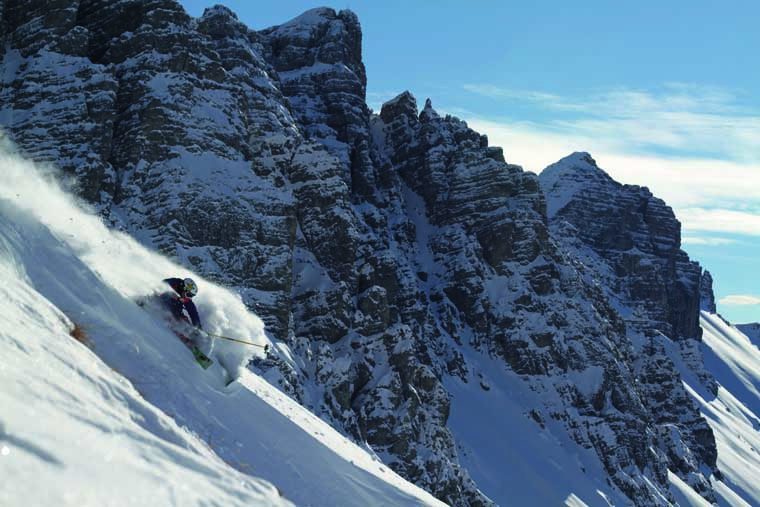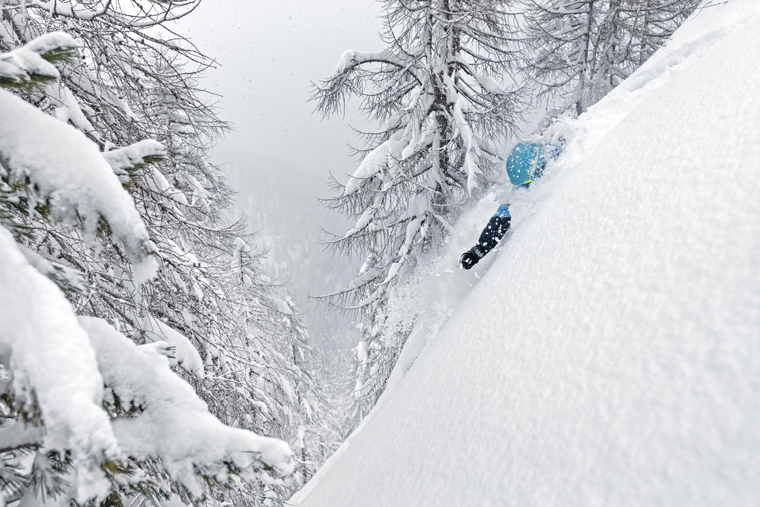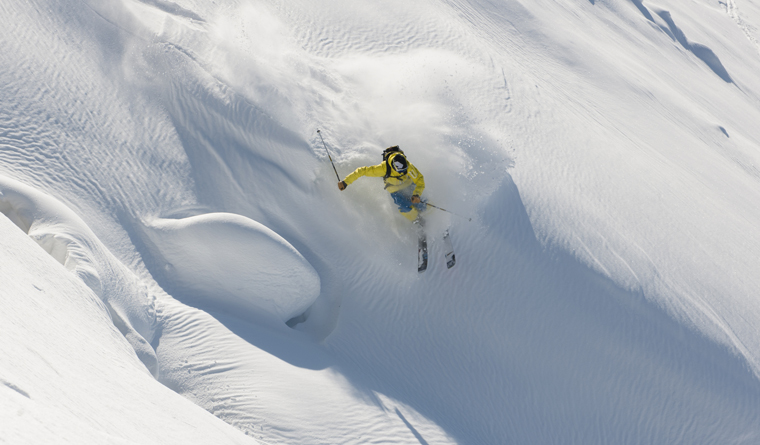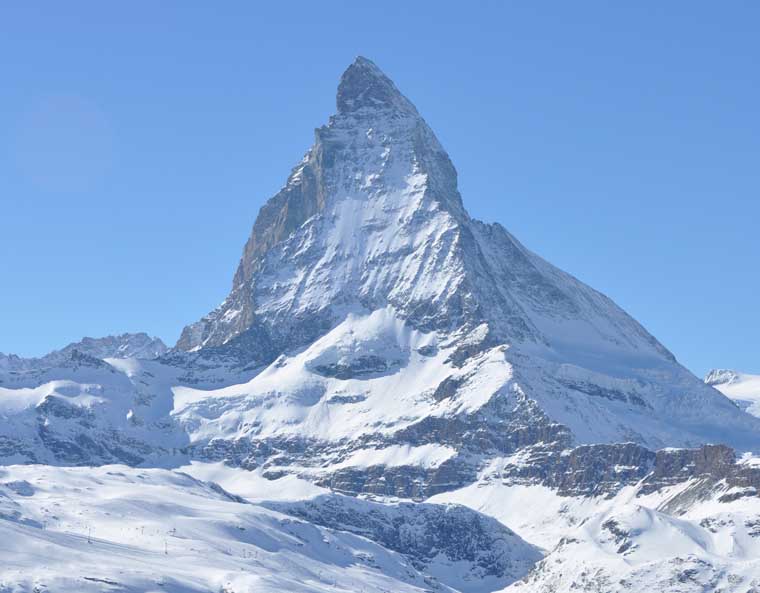Where we’re skiing this winter…


Dickie Fincher, Publisher-at-large
OK, I’ve just had some news that means I really might have to make the most of this season. A previous life motorcycling, plus the odd ski trip, has conspired with a skeleton made of meringue to knock out both hips and at least one upcoming season.
So, with a bit of planning time on my side, I’m aiming to go under the knife directly after this season to try to be back in action in 2017 (book now for 2016, it’s going to be the best winter ever!).
Meanwhile, having missed the monster snow they revelled in this season, I’ve got unfinished business in the Dolomites. If there’s only half as much this coming year, it’s still a guaranteed belter.
Where to start? Well, a scoot up Pordoi cable car near Corvara/Arabba/Selva will deliver a gentle stroll across the top of the Sella – of Sella Ronda fame. More famous in off-piste circles is the Val Mezdi, accessed after said stroll and an even-pitched couloir with a 1400m descent and the odd wriggle to keep you on your toes.
And the views… You’re in the Dolomites, in a giant crack in that beautiful rock. Mezdi means midday, which is when the sun pours down it from the top. Time it right and you’ll be illuminated like a Holy Isle manuscript all the way down.

Since I’m in Italy, I might as well drive 40 minutes to one of my favourite, slightly bonkers resorts. San Martino di Castrozza mixes faded Cortina-like elegance with a well-placed cable car leading to a vast area ripe for shreddage.
Skier’s right of the Rosetta cable car, newly connected to town a year or so back, is a wide powder field with a series of fine runs back down off the dominating lump around here, the Pale (pronounced Pal-eh).
There are also some extremely gnarly routes, including a ski’s-width couloir exiting 10 feet above a narrow shoulder with a nice ski out, as long as you turn in time to avoid the multi-hundred-foot plummet.
There are trees to be skied all around the area, accessed mainly by the Tognola side of the town, plus a couple of excellent mountain huts with typically good food. And another thing; I don’t do busy resorts, and I don’t do mad prices when there’s better value to be found – and San Martino fits both criteria beautifully.
Where else? Norway – the sea to summit (and back down again) dream. Martin (Chester, our backcountry ed) has been teasing us with tales of the North for a couple of years, and I have friends battering down my inbox desperate to experience late season touring in everlasting daylight.
I’m not sure if it should be lodge or boat-based – I’ll take Martin’s steer on this as and when we start planning. It’ll be a cheeky week just at the time I normally mentally resign from the season. It feels exactly like the next thing to do.
Nicola Iseard, Editor
‘Have baby will travel’: that’s going to be my mantra next winter. Or rather, ‘have baby will ski’. I realise that, having a new baby, the majority of my skiing time next winter will be in my backyard here in Morzine – quick dashes up the Pleney while Chrigl, my husband, is on infant-watching duty – but when the grandparents come out, we’ll pile up the Subaru and head to a neighbouring resort for a few hours. First off, Praz de Lys.
I’m not sure what has provoked this change in my attitude, but now one of my key criteria for selecting resorts is room on the pistes. I’ve had enough with crowds. So perhaps the biggest draw to Praz de Lys is its relative anonymity considering how close it is to the busy Portes de Soleil resorts (20 minutes by car from Morzine).
A windy road takes you up to its plateau at a lofty 1450m and although it doesn’t rise much higher than this (the lifts only climb 500m, so 2000m top) there are superb panoramas from Lac Leman all the way to the Mont Blanc Massif. Chrigl found two opportunities to get up there last season, once on a powder day, when he said he was one of only a handful of skiers there (and the only English), lapping run after run.
When it snows there are north-facing bowls, direction Sommand, the sister resort on the other side of the top chair. With a little exploring there are some small steep chutes, but predominantly it is open rolling terrain, rather than tight and technical.
There are a couple of tree runs on the sunny side which I suspect would be epic if caught at the right time, that is to say cold and deep.
Then, come spring, you’re not far from beautiful peaks like Chalune and the Roc d’Enfer, which lead back to St Jean d’Aulps and even Les Gets via the Col d’Encrenaz, so that would all make for some interesting touring possibilities.

Where else? La Clusaz has been on my hit list since we moved out here two winters ago and I saw a clip of the venerable Candide Thovex going for a jolly lap around his home resort in a blaze of spins and choppy straight lines.
If arguably the most versatile skier in the world right now – winner of the Freeride World Tour and countless freestyle competitions – could grow out of those slopes, then it’s definitely worth a visit. Or rather, revisit. I skied it back when I was 14, but don’t remember venturing much beyond the piste poles.
When the going’s good, resorts like this have so much to offer in terms of variable terrain: the Col de Balme is a giant powder bowl, much of which is north facing. Then there’s the L’Aiguille mountain and La Creuse bowl in between, and all the tree skiing on the Etale side… I’m not sure a few hours will be enough in this place, but we’ll give it a go.
Jonny Richards, Editor-at-large
Even semi-regular readers will know I am Japan crazy. A sentence barely passes from my mouth, or Mac, without rambling on about how good it is, how much pow there is and, best of all, how ridiculously cheap it is. Last season’s prices were 30% better than the year before, thanks to the diving yen/strengthening pound, and that’s in what is pretty much a zero inflation economy. No idea what that means? Basically, prices haven’t really gone up since the early 2000s. Whoopee!
Anyway, now you’ve got that rather large carrot to chew on, more about my mission for the season. Oh yes, it’s very military these days at Fall-Line, especially if you are planning to take on the mighty Mt Yotei. Anyone that’s skied Niseko (far and away Hokkaido’s biggest and best area), or Rusutsu (come on, sure you remember than one, it’s got a bloomin’ fairground complete with rollercoaster at the base), can’t fail to have seen and been dominated by the north’s island’s version of Mt Fuji.

It’s a beast, a dormant 1898m volcano with the top section usually wreathed in cloud, and for much of the season an almighty avalanche risk. However, in the right conditions, thanks to Hokkaido’s longest vert descent (with pitch up to 50°), and huge amounts of untouched powder (less than 500 people per season do the climb, apparently) it becomes the ultimate day tour.
Last January, I was all set. Well, pretty set, anyway. I’d not booked a guide (yes, you definitely need one) but I had my air tickets, accommodation, and a backcountry happy friend arriving a few days later for company. I’d even finally bought my own avi gear with the six-hour hike in mind.
But then the first night in my pension, I picked up the local Powder Life magazine (an annual winter mag for Niseko) and there was a big spread which pretty much said “Don’t go and climb Yotei!”, with an account of an Aussie, doing a season, who’d gone up there and been very, very lucky to live. He’d set off a huge avalanche and, from memory, broken both his legs, and possibly his back. Hmm, I thought…
Then I Googled Yotei some more and another account pinged straight up with some poor local (this time well prepared and cautious) again getting caught out, triggering a fall, and being fortunate to survive.
That slowed me up. Plus conditions were far from ideal, with huge amounts of snow during my fortnight stay (I’m not complaining), so I couldn’t have bagged the climb/crater even if I’d wanted to. This January, things will be different!
Oh, and I’d also love to ski Sugar Bowl in California, Daron Rahlves’s local resort. Talk to him and you’ll quickly be brainwashed, he’s so enthusiastic about the mountain and hike options. Squaw, also on Lake Tahoe, I’d love to visit too. Which would make the perfect late-season mini road trip.
Yolanda Carslaw, Acting Editor
For years I’ve been eyeing up the valley that runs between Zermatt and the Monterosa resorts (Champoluc–Gressoney–Alagna). This winter I’m determined to ski it, and to build a DIY traverse around the descent, carrying all I need on my back and staying in the brilliant-value and very comfy huts that are scattered around the Monterosa slopes. It’ll be a softy’s tour, with not-too-early starts, minimal uphill and amazing food, plus guiding if conditions are right. I’ll go with my husband and a couple of friends.
The valley – an old smugglers’ route – runs behind Monte Roisetta and Grand Tournalin, the peaks rising to skier’s left of the main bowl at Valtournenche (the underrated part of the ‘Italian side’). It’s accessed off the right of button lift ‘H’ up to Colle Superiore delle Cime Bianche, where the Cervinia and Valtournenche sectors meet.
We’ll start with a night in Zermatt, staying with friends who run the Walliserhof Hotel (Zermatt’s a good place to have friends: if you don’t and need an affordable bed try the Alphubel, or the Matterhorn Hostel close to the cable car).

I’ll arrange for a Monterosa guide to come up from Valtournenche (just over an hour by car from Champoluc, or he may prefer to skin up our valley). I don’t think the descent is exposed or complicated but I’m not up to route-finding in the wilds. We’ll take the cable car to the Klein Matterhorn (3883m) and zoom over the border to meet him near the button. Then it’s 1400m of vert down to Frachey, just up from Champoluc and linked by lift.
Over the next few days we’ll work our way over the Monterosa’s three linked valleys to Alagna, aiming to explore thoroughly without having to race for the last lift home. We’ll start with a night at Frantze or Stadel Sossoun, both cute little stone guesthouses mid-mountain above Champoluc and Frachey. For a splash-out, we might stop at my namesake hotel, the Jolanda – or rather the Romantik Hotel Jolanda Sport – it’s in the village of Gressoney-la-Trinité rather than up the mountain, but never mind.
Of the other accessible, appealing places to stay on the mountain between Champoluc and Alagna, I fancy the Orestes Hut, as recommended by Fall-Line’s Martin Chester. It’s a modern timber place at the foot of the Eagle Couloir, a descent accessed via the swish Punta Indren cable car.
We’ll round off our adventure with a backcountry descent into Alagna; for instance the Balma route, which follows the Bors valley and passes through an abandoned gold-mining village. A last blow-out meal at the Unione or Montagna di Luce in Alagna and we’ll get a plane home from Malpensa.
If this kind of trip works, lots of possibilities occur to me, such as a rucksack tour of the Zillertal with a night or two at the Kristallhutte. Or a traverse from Kandersteg to Leukerbad, over the Gemmipass, which is cat-tracked for much of the winter.
Now I just need to practise packing as light as I would for a real tour, minus crampons and ice-axe, plus something nicer than long johns to wear at dinner.
Mary Creighton, Digital Editor
I’ve had my heart set on moving to Innsbruck since I visited the city in the summer four years ago, and saw firsthand the gondolas that zoom up from the outer reaches of the town and straight into the Tyrolean Alps. Surely this a city that God built; better than Colorado’s Boulder, a whole 45-minute bus ride from its nearest resort, Eldora, and slam-dunking Vancouver – my previous dream city – which involves a 30-minute journey through urban sprawl to get to Grouse or Cypress Mountain. This summer I finally made the move… and I have endless skiing options almost from my doorstep.
From Innsbruck, the bottom of the Nordkette funicular is a mere five-minute bus ride from the main train station. You can literally shop in H&M and ski the notorious, experts-only terrain (the infamous Hafelekarrinne run, with a gradient of 70%, is one of the steepest in Europe) off the Nordkette top station in the same hour. And that, as far as I’m concerned, is the dream.
But it doesn’t stop there. The local Innsbruck ski pass covers nine resorts and some 280km of pistes. I’ve spent a shameful amount of time staring at maps, looking at what’s on offer (not helped by the fact Google maps now shows piste maps), my heart palpitating with very scroll of the mouse.
Within a 10km radius there are another three resorts: Igls, home to an Olympic downhill course, and Mutters with its sunny tree-lined slopes, which links to Axamer Lizum and its impressive sidecountry terrain.

Widen the search area more and there are resorts worthy of a trip in their own right – high, snow-sure Kühtai (where Fall-Line heads for its ski test every year), Seefeld with its flattering network of reds and blues, Shlick 2000 with forests of trees and even pre-season skiing courtesy of the Stubai Glacier, all within a 45-minute drive.
If I look at what I can reach within an hour (Mayrhofen, Sölden and Kitzbühel to name a few) I can almost hear my skis trying to break out of the attic. My weekends are sorted for the next five years.
But the problem with working on a ski magazine is that my bucket list is not limited to the Tyrol. Ever since we ran a feature on skiing in Bosnia and Herzegovina a couple of seasons ago, I’ve been trying to wangle a trip out there.
Again, the mountains jut straight out of city, but this time it’s the Bosnian capital and one of the snowiest urban centres in the world, Sarajevo. There are two resorts within half an hour of the airport: Jahorina with just eight lifts and 20km of forested slopes, and Bjelasnica, which is even more petite but boasts steep, powder-covered terrain.
It’s certainly not the size of the piste map that attracts me, it’s the fact they are almost unknown resorts – ones where English is hardly spoken and tour operators are non-existent – on a new mountain range (the Dinaric Alps) with different terrain in a corner of the world I’ve yet to visit.
The sense of adventure is heightened by the dangers that lurk beneath the powder; the risks of out-of-bounds skiing aren’t limited to avalanches and hidden crevasses, but mines – potentially deadly reminders of the Yugoslavian conflicts that plagued this corner of the world for a decade. And I’ve heard the beer is pretty good, too. FL